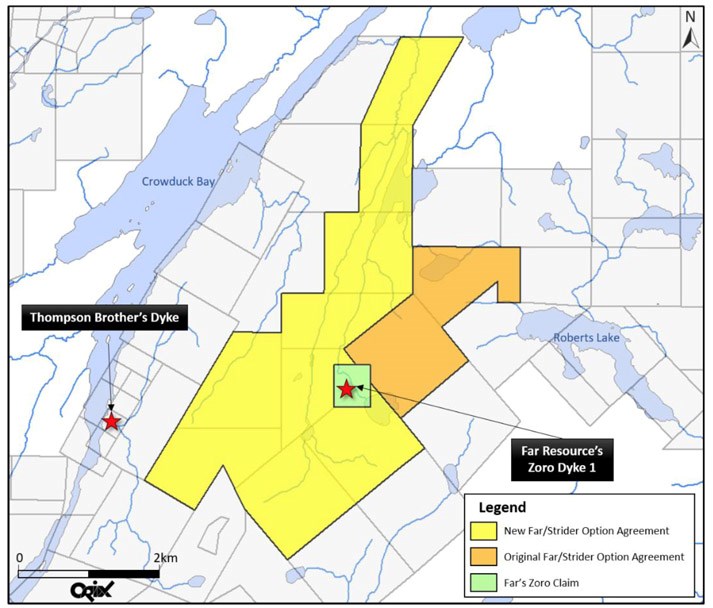On the morning of last Nov. 27 Far Resources Limited announced that the company had entered into a non-binding memorandum of understanding (MOU) with Quantum Resources Limited, which is another exploration company prospecting for lithium on the east side of Wekusko Lake.
Quantum holds the right to earn an interest in the Thompson Brothers lithium project, which is adjacent to Far Resource’s lithium holdings in the same area.
Under the MOU, the two companies agreed to exchange information and work together to assess the viability and potential collaborations in developing their area lithium assets together over the course of a one-year period. The memorandum may be extended or terminated by either party on written notice to the other party. During the period of the MOU, the parties will explore the most effective and mutually beneficial way to move their projects forward.
“I am excited about the potential that can be unlocked by working together with Quantum on our lithium projects in Manitoba,” said Far Resources President and CEO Keith Anderson. “The MOU represents the possibility for operational synergies and development options that will benefit Far Resources and our shareholders. We will be actively proceeding to investigate these possibilities to the mutual benefit of all stakeholders.”
Two days later, on the morning of Nov. 29, the company announced it had received final assay results for core samples from its recently completed drill program
A total of 207 drill core samples were shipped to Ancaster, Ontario for multi-element assay. Analysis confirmed multiple narrow intersections of lithium are present in all five drill holes. Wider intervals with elevated Li2O include 1.43 per cent Li2O over 20.6 metres and 1.15 per cent Li2O over 12.4 metres. Higher grade intervals are present including 2.19 per cent Li2O over 4 m and 3.12 per cent Li2O over 1 m. Tantalum and niobium range between 32 and 152 ppm and 88 and 408 ppm, respectively.
The company says that they are intrigued by a recent high-grade drill intercept of tantalum accompanied by elevated tantalum and niobium in samples of drill core, outcrop and soils. “At this point in the exploration of the Zoro property the significance of elevated tantalum and niobium is unknown but will be closely assessed as exploration proceeds,” read the release.
Furthermore, interpretation of soil geochemical data from the company’s first phase of soil surveys documented strongly elevated lithium, tantalum and niobium responses adjacent to pegmatite dykes and in areas where highly prospective ground is buried beneath soil cover. “Based on the success of Phase 1 soil geochemical surveys field crews are currently expanding the program on the property,” the company said. “Their goal is to continue prospecting for new, exposed pegmatite dikes and expand the soil surveys on newly optioned ground.”
In respect to drilling, a winter program is planned to assess deeper levels (>150 m) of Dike 1 for the extension of lithium spodumene and to test historic drill intersections as well as recent assay results from trench and outcrop sampling.
“The completion of this phase of drilling, including receipt of our continued high-grade lithium assays from all drill holes, has encouraged us to test the deeper levels of Dike 1 for continuity of the high-grade lithium intersected to date,” said the CEO. “We are also ecstatic about the potential for tantalum mineralization on the property based on our 0.117 per cent Ta2O5 (927 ppm Ta) drill core assay. Although the geologic significance of tantalum in Dike 1 is not fully understood, we shall continue to work on patterns of mineral zonation to provide possible vectors to additional zones of tantalum in Dike 1. Our drill program planning also includes aggressive testing of additional high-grade lithium-bearing pegmatite dikes defined on our option ground and new drill targets based on the results of our ongoing prospecting and soil geochemical surveys.”
Tantalum is a rare, hard, blue-gray, corrosion-resistant metal that is widely used as a minor component in alloys. The chemical inertness of tantalum makes it a valuable substance for laboratory equipment and a substitute for platinum. Its main use is in tantalum capacitors in electronic equipment such as mobile phones, DVD players, video game systems and computers. Tantalum occurs together with the chemically similar metal niobium. Tantalum sells for approximately $128,000 USD per metric ton.
Niobium is used mostly in alloys, the largest part in special steel, such as that used in gas pipelines. Although these alloys contain a maximum of 0.1 per cent, the small percentage of niobium enhances the strength of the steel. The stability of niobium-containing super alloys at high temperatures is important for its use in jet and rocket engines. Niobium is also used in various superconducting materials. These superconducting alloys, also containing titanium and tin, are widely used in the superconducting magnets of MRI scanners. Other applications of niobium include welding, nuclear industries, electronics, optics, numismatics and jewelry. Niobium metal sells for approximately $41,000 USD per metric ton.




